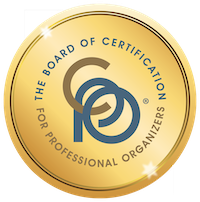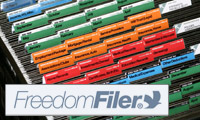Worth repeating: Completing a jigsaw puzzle five pieces at a time
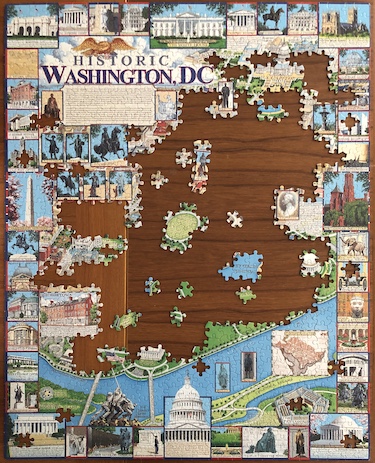
I originally published this post just seven months ago, but since so many people are doing jigsaw puzzles these days, I think it’s worth repeating. I’ve had several people say to me that if they start a puzzle, they can’t pull away from it and will stay up all night until it’s completed. And therefore they don’t do puzzles! Perhaps I’m just wired differently, but I love my five-piece-at-a-time method because I can sneak in small, enjoyable snippets of puzzle-solving without it taking over my day. And this method allows me to extend my enjoyment and savor the puzzle! The picture is of the puzzle I’m currently working on, Washington, DC from White Mountain Puzzles. I’m thoroughly enjoying it. (It makes me want to visit Washington, DC, where I lived for five years after college!)
I enjoy doing jigsaw puzzles. One-thousand-word puzzles are just the right size and my favorite kind to do are collage puzzles. I think I like collages because of all the easy sorting that can be done.
Last month I completed a 1000-word collage puzzle five pieces at a time and mentioned it on Episode 68 of Getting to Good Enough, the podcast I host with Shannon Wilkinson. I’m just about to finish another puzzle using this method, which I devised for myself, and I find the method so successful (and relevant to other parts of my life) that I thought I’d share.
I do jigsaw puzzles at the end of our dining-room table. There’s room there, since there are only two us of eating (unless we have guests). But I don’t want a puzzle to languish there untended. I also don’t have hours a day to devote to doing puzzles. And I don’t want to wreck my productivity on a workday by getting sucked into a puzzle. So here’s what I do.
I start by connecting the edge pieces of the puzzle, which has always been my favorite part of the puzzle. (I can’t imagine working on the interior with the edges set up…I wonder what that says about me?)
Once I have the edge pieces connected, I tell myself that I will connect five puzzle pieces and then I’ll stop. That’s it. It’s that easy.
Much of the time in the early stages of completing a puzzle is spent sorting. With collage puzzles, I sort pieces into likely sets. I use empty boxes for the sorting. (At last! a use for those Apple boxes I can’t seem to throw away.) To achieve my pieces, I will connect pieces within those sets and/or I’ll connect pieces within the puzzle itself. If I connect a group of already-connected pieces into the puzzle, that counts as one piece.
This is the puzzle I’m currently working on (The Games We Play from White Mountain Puzzles), taken a week ago.
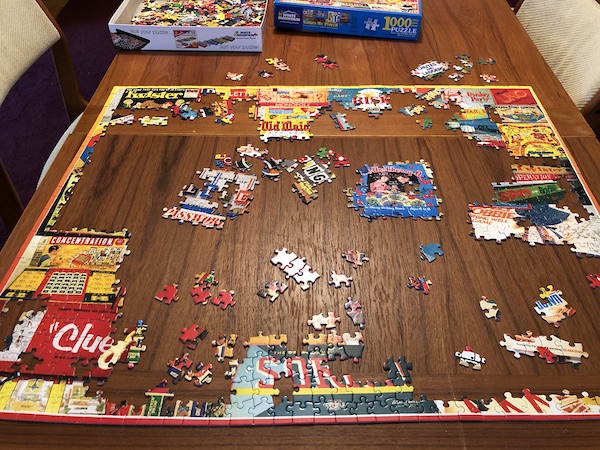
Here are some of the boxes of sets.
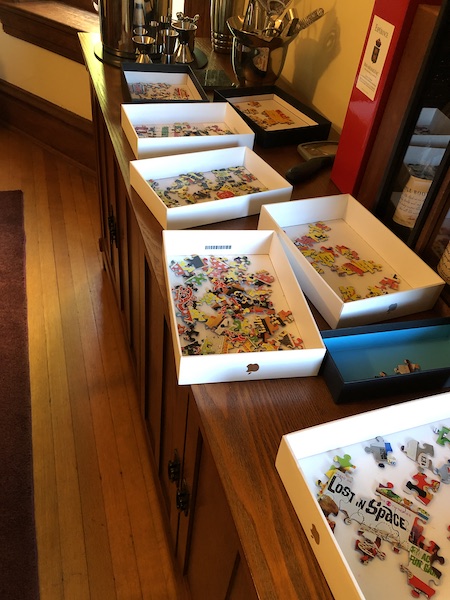
And here is the puzzle this morning. I’m almost finished! This puzzle has been particularly enjoyable.
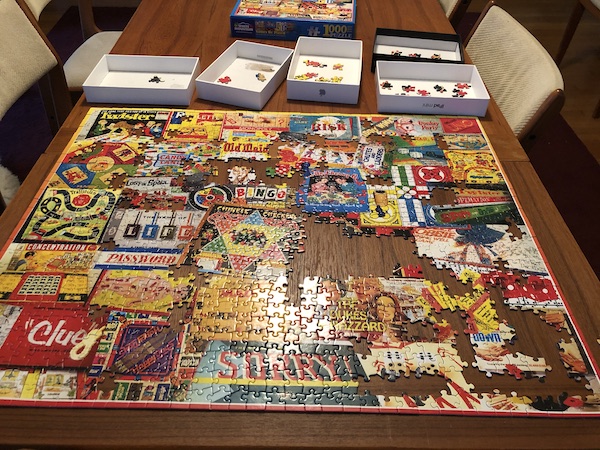
As I see it, here are some of the benefits of my five-pieces-at-a-time method:
- It makes the puzzle feel very achievable
- The goal is so small I can easily grab a little pocket of time to do it, so the puzzle doesn’t languish
- I get to enjoy working on the puzzle many times a day
- I don’t get so caught up in the puzzle that I don’t go to bed or work (it’s kind of like setting a timer)
- I get the pleasure of watching the puzzle emerge slowly
- I get to enjoy little achievements over and over again while doing the puzzle
I think that last point might be most important and also really relevant to other (non-puzzle) tasks. By setting tiny goal after tiny goal, I get the thrill of achievement each step of the way. I am literally never frustrated by a puzzle because I can always find five pieces to put together. (That might be because I like collage puzzles…I think I’d find puzzles with vast swatches of monochromatic areas frustrating.)
Next time I get stalled or frustrated while working on a project, I’m going to think about how I might make it more like a jigsaw puzzle and just set my sights on connecting the next five pieces.
Tiny projects challenge: Day 5
On this fifth and last day of my personal tiny projects challenge, I moved out of my office to the living room and spent less than 15 minutes on the end table next to the chair where I watch TV, write postcards to voters (and in doing so practice my hand lettering) and knit.
I use different lettering techniques on my postcards depending on the content. So I bring to the end table different pens from my collection (stored elsewhere in the living room) to figure out how I want to letter. The trouble is, I’m not so great at putting the pens back. The clutter had reached critical mass by yesterday morning when I took this picture:
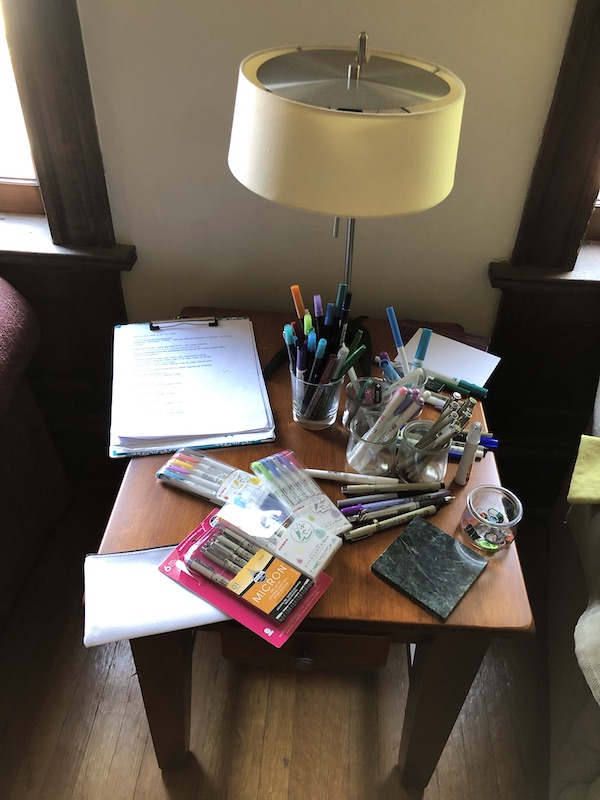
I set my stopwatch this time, so I know that it took me only 13 minutes this morning to get from there to this:
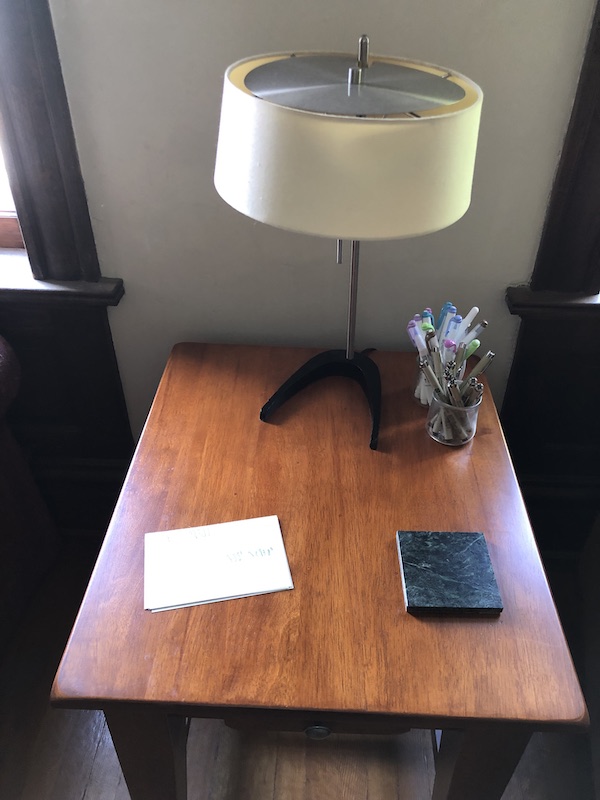
In that time, I separated out the pens that I’m using in the current postcard project, giving myself plenty of choices of colors, and tested all the black mono-line pens, since I knew some were wearing out. I threw away the bad pens and put the good ones together in a jar. I stored the colored pens that I’m not using on my current project, so now the pens that I want immediate access to fit in two tidy jars.
I had started five postcards last night and they remain on the table, and I moved my clipboard with addresses to my postcard supply area. It all feels great, though I realize now that I need to turn to my attention to my larger collection of pens, which has gotten a bit unruly.
My takeaway: I’ve noticed this week that by setting a timer and mindfully taking on a little challenge, rather than simply tidying up, I’m taking extra beneficial steps. This time I actually tested pens so I could toss dead ones and checked for expiration dates so I could throw away expired snacks. On Day 1, I actually scanned and filed, rather than tidying those papers into an orderly pile!
I’m going to stop blogging about my tiny projects, but I won’t stop doing them. I hope these posts have provided you a little inspiration for selecting some small and doable organizing projects so you can enjoy frequent wins and feel productive. It’s certainly felt good to me this week—and I invested a total of only about 90 minutes!
Tiny projects challenge: Day 4
I focused my attention on my printer stand/snack bar today. In about 20 minutes, I decluttered and tidied this little space and it felt great!
Let me explain the snack bar: I buy snacks like packets of nuts and snack bars that I take with me to client appointments so I can nosh when I’m hungry without interrupting my work. I typically buy the snacks at Costco and I store them on top of my printer stand, next to my printer.
In the printer stand I store paper (both printer paper and premium paper that I use for hand lettering), along with mailing envelopes, file folders and cardboard to make envelopes stiff. It’d been awhile since I spent any time with the contents of the printer stand and things had devolved a bit.
Here’s a picture of the printer stand before I got started. Not pictured was a partially full Costco box of snack bars on the windowsill.
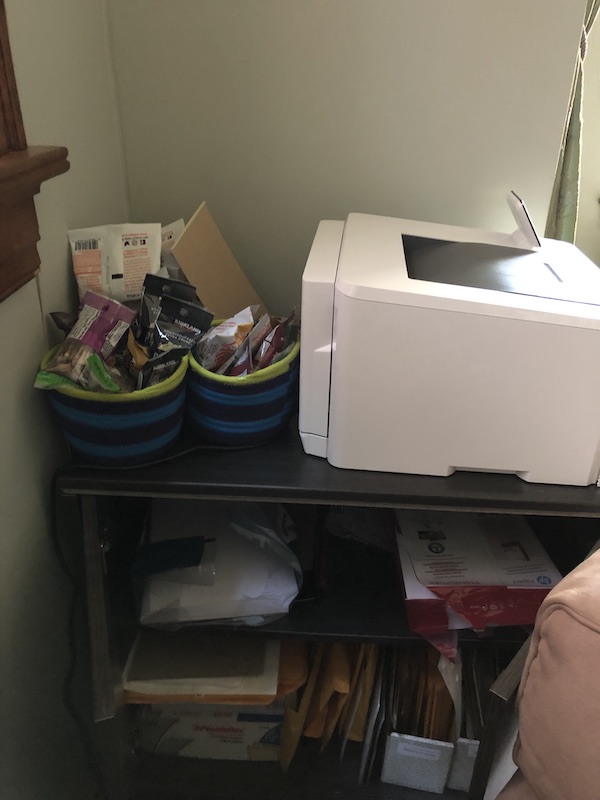
And here’s how it looked twenty minutes later.
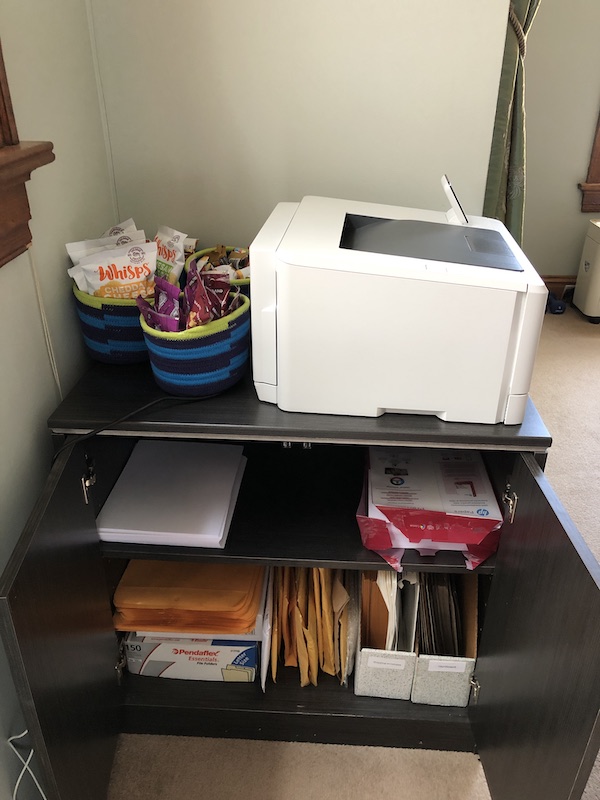
It took me ten minutes to tackle the snack bar. I went through the snacks and discarded the expired ones. (Quite a few had expired!) With the space I gained, I was able to integrate the bars from the windowsill into the containers on the printer stand and get that unsightly box off the windowsill.
Inside the printer stand, I put like things together, took my regular printer paper out of its packaging for easier access and recategorized what went into the magazine holders. And I took a moment to create a new label so the magazine holder labels reflect reality.
I took note that I need to buy some more printer paper and also some more of the tea I buy in bulk and usually store between the two types of paper. I also moved Bix’s armchair so that I could open the printer-stand doors more fully.
I have to say, this was a satisfying tiny project. The little bit of work I did today will make accessing snacks, paper and envelopes easier. It felt great. The photos don’t do it justice!
Tiny projects challenge: Day 3
Today, I focused on my desktop (the top of my actual desk, not my computer desktop). I forgot to set my timer and I was watching Anderson Cooper on Stephen Colbert’s show at the same time, so I don’t know how long it took. But I’m confident it would have taken less than 15 minutes if I’d been focused on the task at hand.
Here’s the before shot. If I don’t clean up my desk at the end of the work day, this is how it usually looks when I arrive at my desk in the morning.
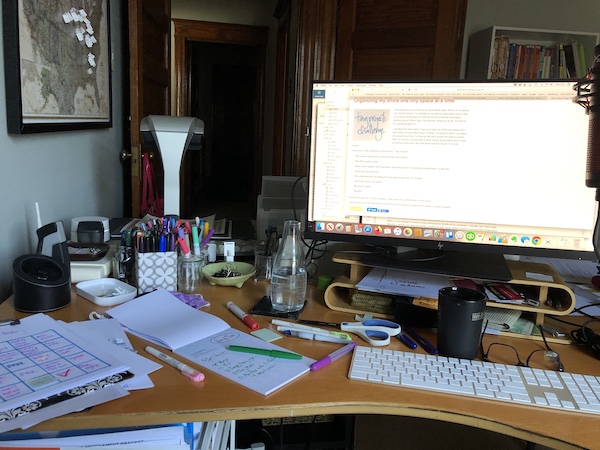
And here’s the after shot.
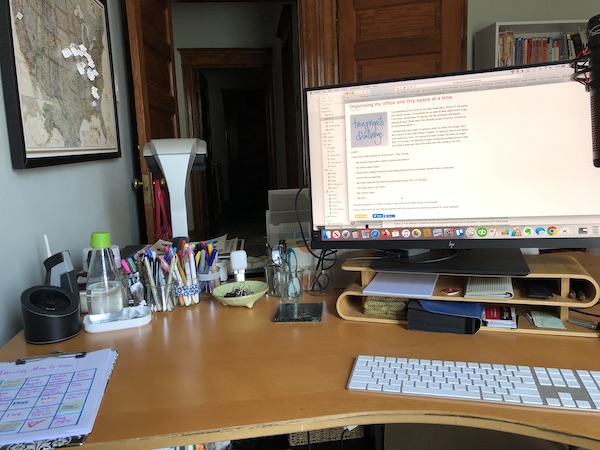
I actually did do a little more than tidy up. I went through the square pen cup that’s been on my desk. I realized that I use about two of those pens on a regular basis (usually I use my lettering markers, in the glass jars). So I tested all the pens in the pen cup and discarded the half dozen that didn’t work. The rest were Sharpies and highlighters. I put them away in the Sharpie area of my office-supply closet. (I may have a Sharpie problem.) I was left with a few fine-point pens, which I put in a Oui yogurt jar for easy grabbing.
I also went through the papers in the small pile on the edge of the desk and created a couple of files I put in the file box behind me on the radiator.
I’m so glad that I committed to these five days of tiny projects. They’ve each had a great payoff for a small time investment!
Tiny projects challenge: Day 2
Today I tackled two desktop file bins of paper that at one time were Action papers but that had languished due to inattention. It wasn’t a whole lot of paper, but these two bins were cluttering up my office—and my psyche. (To be honest, these bins were much fuller about six weeks ago, but they were among the first things I dealt with at the beginning of the stay-at-home order, so today’s project focused on those items I hadn’t dealt with over the last six weeks, as well as some papers added during that time.)
The larger bin had been hanging out on top of the shredder (making the shredder less accessible) and the other was on the radiator directly behind my desk. I put the two together for this picture.
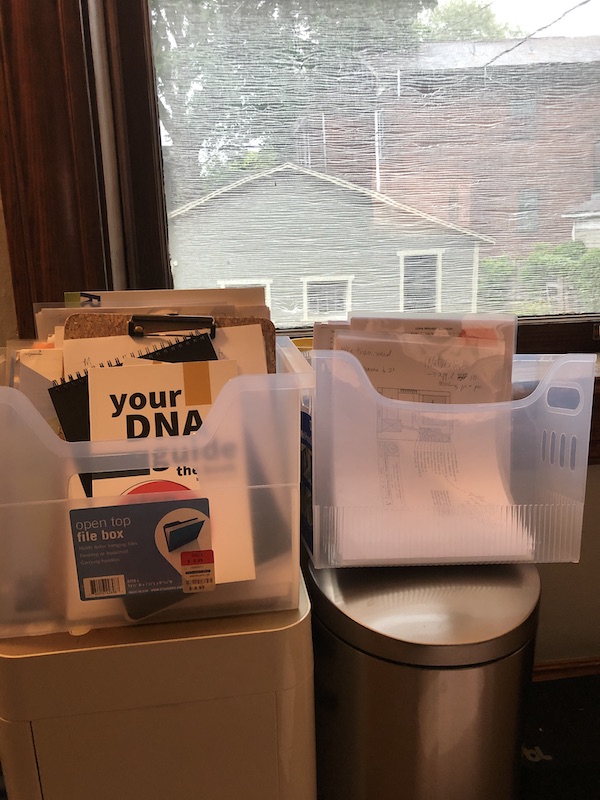
It took me twenty minutes this time, but when I finished, I whittled the papers down to one smaller bin. (It’s small Multi-Purpose bin from The Container Store.)
Here’s a picture of what’s left:
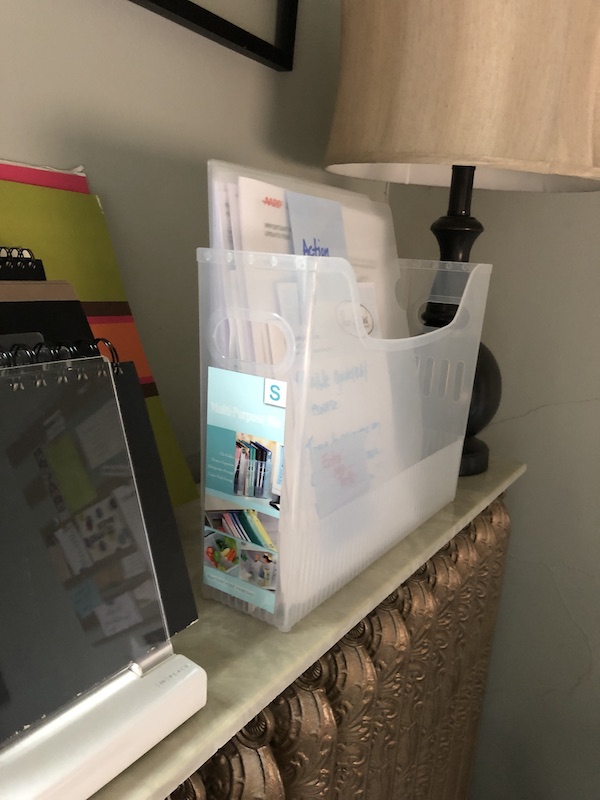
In those twenty minutes of focused attention, I discarded some papers after deciding I didn’t want to deal with a project anymore. I put some papers together and moved them to a closet. I filed a few. I shredded a bunch. I moved the book to a bookshelf. What’s left is a fairly small Action file with clearly defined actions, as well as a few current files I wanted to keep close at hand. (I like to group papers into clear plastic file jackets and use a sticky note to label them.)
Look for another post tomorrow with another tiny project!
Tiny projects challenge: Day 1
I decided to kick off my five tiny-project challenges this week with my scanner stand. It’s a repurposed printer stand (it’s got to be 20 years old) that I use for my ScanSnap S1500M sheetfed scanner and my ScanSnap SV600 contactless scanner. It had become a bit of a dumping ground.
Here’s the before shot:

Fifteen minutes later (woot!) here’s the after shot:

All this took was a little focused attention. In those 15 minutes, I:
- scanned, then discarded, three documents
- filed two documents
- moved books to a bookshelf
- moved the 23andme DNA test to my desk to consider actually doing
- put the old photos my husband asked me to scan front and center so I’ll actually scan them
- put my little dish of push pins where it belongs
That was 15 minutes well spent. I had completely forgotten about those photos and now will be able to scan soon. The scanner stand is the first thing I see when I walk in my office and I also see it when I’m sitting at my desk. So it feels great to have some visual peace!
Organizing my office one tiny space at a time
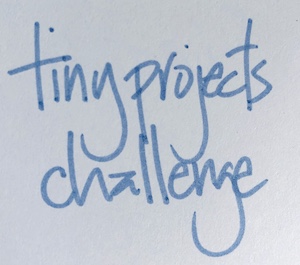
I am spending a lot of time at my desk these days. Since I’m not going into clients’ homes, I’m probably at my desk at least eight hours a day, if not more. Some days I’m staring into the computer and barely looking around. Other days, the disorder jumps out at me. It’s time to do something about it.
I decided that next week I’m going to whip my office into shape. But I don’t want it to be a Big Project. Instead, I’m going to take it one teeny tiny project at a time. I’m hoping that each project will take no longer than 15 minutes. I’ve decided to keep myself accountable and on task by writing a post each day next week with the results of my tiny project.
I have lots of little projects to choose from. They include:
- My scanner stand with a stack of books and detritus
- My office supply closet
- Some action papers that have been languishing since my business slowed down so abruptly
- Some built-up scanning
- My under-desk file cart (that will surely take longer than 15 minutes)
- The snack area in my office
- My monitor stand
- My pens
And the list goes on. If I catch a wave, I may move on to other areas of the house.
If you’d like to join me, feel free to comment with the area you’re planning to tackle (or have tackled)!
Links
- Getting to Good Enough podcast
- Institute for Challenging Disorganization
- National Association of Productivity and Organizing Professionals
- Shannon Wilkinson, life coach
- Are you interested in becoming a professional organizer?
- NAPO St. Louis
- Ravelry
- Organize Your Family History
- Peace of Mind Spending

